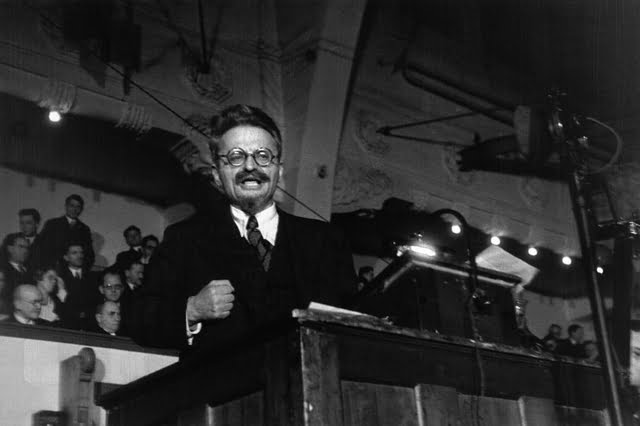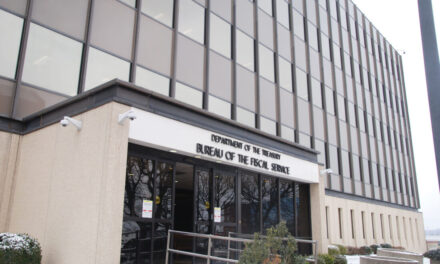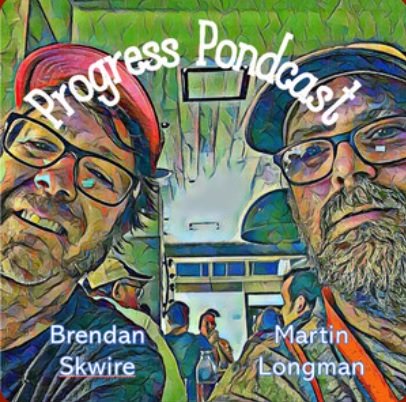I was in college studying philosophy when the Berlin Wall fell and later when the USSR dissolved. From my perspective, one of the great unappreciated benefits of those events was that we didn’t need to argue with Marxists and Trotskyites anymore. The whole dialectical materialism scam was so tiresome, especially if you had to engage with it as someone on the progressive left.
The demise of communism also gave me the space I needed to gain some appreciation for Leon Trotsky. He was a pretty insightful thinker when it came to understanding things that were wrong. His problem was in his solutions. Still, it would be interesting to rewind history to see how the 20th-Century would have unfolded differently if he, rather than Stalin, had taken the reins of the Soviet Union after the death of Lenin. Instead, he was exiled and ultimately murdered by Stalin’s order. But that’s really a subject for another time and a throwback to the kind of debates I loathed as a college student.
Trotsky watched the rise of Nazi Germany from exile, and one year after Adolf Hitler took power in January 1933, Trotsky wrote an essay called Hitler’s National Socialism that is really very interesting to read over 90 years later. It’s a diagnosis of how the communist or socialist (as they called them) revolutions in Europe, especially in Germany, failed in the aftermath of World War One and why fascism took their place as an engine of change.
This was no small thing in 1934, when Trotsky wrote the essay. The split between he and Stalin was based on a disagreement over whether socialism could succeed in the USSR if the more advanced economies of the world didn’t come along for the ride. Once it became clear that, at least in the short term, this was not going to happen, Stalin shrugged it off and advanced the idea that socialism could exist and thrive solely in one country. He became less interested in promoting communism abroad and put his focus on making it succeed at home. Trotsky felt that communism in the USSR would ultimately fail if it didn’t take root in Western Europe and America. So, for him, understanding why it hadn’t taken root in those places was of the utmost importance.
Unsurprisingly, Trotsky’s analysis utilizes Marxist terms and concepts, none more central than the petty or petite bourgeoisie. The term describes people who don’t neatly fit as either capitalists or laborers. This is because they’re mainly self-employed as small-business owners or artisans. They were thought of as kind swing voters who could take the side of either big business or labor depending on the prevailing economic conditions. And the prevailing economic conditions in Germany in the lead-up to Hitler’s ascension to power could hardly have been worse.
From the outset of his essay, Trotsky is at pains to argue that it was mistake to attribute Hitler’s success so far as mainly attributable to his unique skills.
…the leader is always a relation between people, the individualistic supply to meet the collective demand. The controversy over Hitler’s personality becomes the sharper the more that the secret of his success is sought in himself. In the meantime, another political figure would be difficult to find that is in the same measure the focus of anonymous historic forces. Not every exasperated petty bourgeois could have become Hitler, but a particle of Hitler is lodged in every exasperated petty bourgeois.
What he’s suggesting here is that Hitler was a product of or response to a demand, and so more of a follower than a leader. Later on, he makes this point clearer:
As you read it, I think you’ll readily see how well it describes the rise of Donald Trump.
Certainly, Trump began his political career almost inadvertently by becoming the leader of the Birther Movement that questioned whether or not President Barack Obama had truly been born in Honolulu. The idea was that he had actually been born in Kenya, like his father, and was therefore ineligible to serve as president.
This false and absurd theory absolutely required a bold, self-assured temperament and loud voice.
His willingness to take on this role made him a darling of everyone who held Obama responsible for their dissatisfaction with the status quo. But Trump didn’t, as yet, have any program or clear political agenda. These things developed as he interacted with the people who responded positively to his Birtherism. These were folks who were dismayed that America had elected a black president and saw it as a sign that the country was slipping away from them. So, as Trump made his appearances, he began to improvise and respond to the approbation he received from his audiences. He would try out material and keep and emphasize what had resonated, while dropping what had not.
Much of the material that resonated was related to race and immigration, and the way the browning of America was seen as an almost irreversible loss. There was also material that touched on the hollowing out of industrial America and traditional labor jobs, or the pinch small businesspeople (the petty bourgeois) felt from the pressures of globalization.
As Trump listened to the “oratorical acoustics” of his own speeches, he began to form more concrete political thoughts. The slogans followed, beginning with “Make America Great Again,” Still, his political thoughts were shallow. He attacked free trade deals, for example, but not the monopolists most responsible for the “ruined and drowning people” of America’s Rust Belt.
As he turned toward an actual political career, his speeches were attuned to the pitch of the types of dissatisfaction he heard in response, but his consolations were still little more than formless and sentimental nostalgia for a long-long past.
What emerged was kind of beggar’s sack of grievances all bound up in MAGA. This is how his program consolidated. This is how the “leader” took shape out of the raw material. When he discovered that people loved it when he said he will build a wall on the southern border and make Mexico pay for it, he kept saying it at every stop. Soon it was an actual policy, however insulting and unrealistic it might be in practice.
Before long, he realized that being insulting and unrealistic was actually at the heart of his appeal, and so he went searching for new ways to insult people and make impossible promises. This proved to be an unstoppable strategy and new force in American politics, but it was very much an example of “an individualistic supply to meet the collective demand.” It’s true that Trump found a segment of America that “wanted to thump with their fists on the table,” and also true that we was better than anyone else at the job. But he has only led the masses in the direction they were pushing, not the other way around.
Just as importantly, while Trump’s harangues sound like commands and prayers to his admirers, he has never had a clue how to cure the evils he promises to address. Formless, and even forlorn, sentimentality combined with ignorance and endless conspiracy theories dressed up as erudition won’t solve complicated problems.
The similarities between Trotsky description of Hitler circa 1934 and the Trump of 2015-2016 don’t stop here.
While the Nazis acted as a party and not as a state power, they did not quite find an approach to the working class. On the other side, the big bourgeoisie, even those who supported Hitler with money, did not consider his party theirs. The national “regeneration” leaned wholly upon the intermediate classes, the most backward part of the nation, the heavy ballast of history.
Trump’s whole first term in office could be described the same way, with traditional monied Republicans (big versus petite bourgeoisie) contributing to Trump’s successful campaign but very much not feeling that his party was theirs. It was too boorish, too provincial, and essentially an embarrassment. But from a policy perspective, it was the workers and the small business owners who were sold out, and that’s even more true now in Trump’s second term.
How is it that they seem not to notice? When it comes to the petite bourgeoisie, Trotsky has an answer:
Political art consisted in fusing the petty bourgeoisie into oneness through its solid hostility to the proletariat (working classes). What must be done in order to improve things? First of all, throttle those who are underneath. Impotent before large capital, the petty bourgeoisie hopes in the future to regain its social dignity by overwhelming the workers.
The Nazis call their overturn by the usurped title of revolution. As a matter of fact, in Germany as well as in Italy, Fascism leaves the social system untouched. Taken by itself, Hitler’s overturn has no right even to the name counter-revolution…the party that stood at the head of the proletariat returned the power back to the bourgeoisie.
German Fascism, like the Italian, raised itself to power on the backs of the petty bourgeoisie which it turned into a battering ram against the working class and the institutions of democracy. But Fascism in power is least of all the rule of the petty bourgeoisie. On the contrary, it is a most ruthless dictatorship of monopolist capital.
This is why we see Trump straining to perpetuate his 2017 tax cuts for the rich and pay for it with the health care of the working classes. It’s why Trump is working overtime to curry favor with the very monopolists who are crushing small business owners and artisans. But this intermediate swing voter class that is being crushed under Trump is largely still on board.
In Germany, they were sold on a kind of mystical nationalism based on racial purity and “true” German culture.
Recollections of the “happy” days of free competition, and hazy traditions of the stability of class society; hopes for the regeneration of the colonial empire, and dreams of a closed economy; phrases about a reversion from Roman law back to the Germanic…an envious hostility to inequality in the person of a proprietor in an automobile. and animal fear of equality in the person of a worker in a cap and without a collar; the frenzy of nationalism, and the fear of world creditors. All the refuse of international political thought has gone to fill up the spiritual treasury of the neo-Germanic Messianism.
In other words: Make Germany Great Again!
In Trump’s America, whites are under attack. They are the victims of discrimination. They can’t gain acceptance to the country’s finest universities. Their cultural heritage is maligned in our museums and national parks. Their heroes are cast as villains and their statues are torn down. Their religion is disrespected and cast as bigotry, backwardness and hatred. His supporters will gladly trade “the institutions of democracy” for a strong leader who will defend them and restore them to their proper place. Their leader will restore the stability of traditional society and the security of a closed economy. He’ll make sure traditional American law isn’t undermined by woke international law and that our country will be respected again as it was at the height of our colonial empire.
This is effective not only with the petty bourgeoisie but with the “worker in a cap and without a collar.”
The similarities here are overwhelming, which makes Trotsky’s warning about the direction of the Nazis in 1934, all the more important.
Reducing the programme of petty bourgeois illusions to a naked bureaucratic masquerade, National Socialism raises itself over the nation as the purest form of imperialism. Absolutely false are hopes to the effect that Hitler’s government will fall tomorrow, if not today, a victim of its internal insolvency. The Nazis required the programme in order to assume the power; but power serves Hitler not all for the purpose of fulfilling the programme. His tasks are assigned him by monopolist capital. The compulsory concentration of all forces and resources of the people in the interests of imperialism—the true historic mission of the Fascist dictatorship—means the preparation for war, and this task, in its turn, brooks no internal resistance and leads to further mechanical concentration of power. Fascism cannot be reformed or retired from service. It can only be overthrown.
It’s not clear to me that Trump’s MAGA movement is inexorably headed to foreign adventure and war, but its notable that threats to Gaza, Panama, Canada and Greenland were lacking in his first term but are omnipresent now. What’s clearer is that the movement is going beyond “the institutions of democracy” toward “the compulsory concentration of all forces and resources of the people in the interests” of the party.
If hopes that Trump’s government fill fall today or even tomorrow are indeed “absolutely false,” and it’s true that MAGA cannot be “reformed or retired from service,” then it follows that the only solution is that it is overthrown. I don’t say this to urge the abandonment of hope in the political process (the midterm elections, for example) or remedies from the courts. We should do everything we can to make the system self-correct as it is designed to do.
But I also know what happened after 1934. Trotsky was wrong about many things, but he saw quite clearly where Nazism was headed, and why.









This is the kind of deeply informed and thoughtful perspective that’s all but impossible to find elsewhere on the intertubes. (And just another reason to support this site; subscribe today!)
I see the parallels quite clearly. What I don’t see is the magnitude of the crisis. The War in Iraq and its political failure was a pretty big deal, as are immigration and inflation… all the stuff right-wingers complain about over the course of centuries. But Germany in the wake of WWI is just on a different level. The reality on the ground seems like a nursery for radicalism, whereas – not to discount the suffering of some Americans – the reality on the ground in the US ca. 2022 was pretty good! The radicalism is of an entirely manufactured nature.
Am I just some coddled elite for not seeing it?